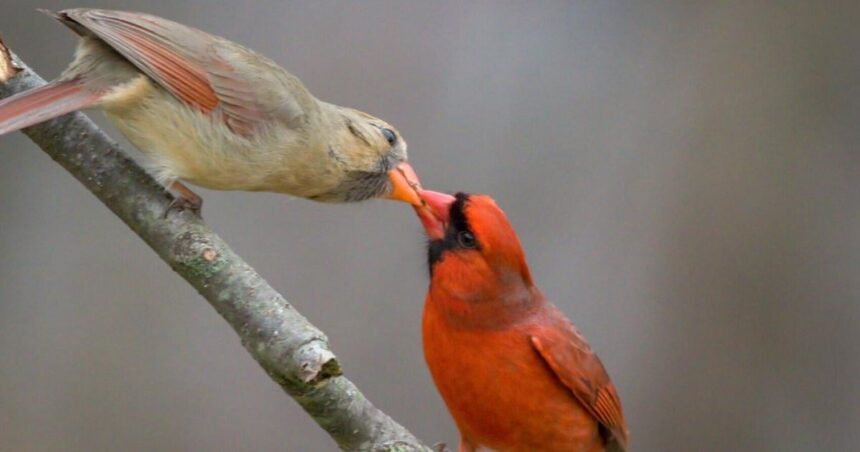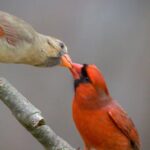I toss a small handful of sunflower kernels onto our patio each day. For the past month or so, a male cardinal has perched himself near our patio sliding door several times a day, making himself known by flying around and getting near to the door to make sure we see him.
I noticed that he had often been accompanied by a fat female. He often takes a kernel to her and feeds her, beak to beak. She shakes a lot as he does this. She never feeds herself, and she shakes only when being fed by him. Is this normal behavior, and what does it signify?
– Steve, Manhasset, New York
The male’s frequent visits and display near your back door are typical territorial behaviors during breeding season. He’s establishing his territory. The male feeding the female is a common courtship behavior. By providing sustenance, he strengthens their bond, allowing her to conserve energy for egg-laying and incubation to ensure successful breeding. The female’s shaking could indicate trust or excitement. Bird behaviors are fun to observe. Enjoy!
People are also reading…
We have three cats, all of which eat canned food twice daily. Dry food is available 24/7. One of them, a 13-year-old female, was gone from our home for a month. She weighed 11 to 12 pounds when she left and returned, starving, according to our vet, weighing only 6.6 lbs. She was skin and bones.
Three months later, she started begging for wet food six or eight times a day. Being a softy and because the dry food often gets thrown up, I give in most of the time. It’s a bother, but I do love her. Do you know why she has become a bottomless pit?
— Jim, Tucson, Arizona
After her month-long absence and severe weight loss, it’s understandable that her behavior around food has changed significantly. There are several potential reasons for her increased appetite and intolerance to dry food.
First, after experiencing such severe starvation, her body is likely in a state of recovery, requiring more nutrients and calories to regain lost weight and rebuild muscle. This can manifest as a seemingly insatiable appetite.
Additionally, the stress of being lost and starving could have long-term effects on her behavior. She might be eating more as a coping mechanism, driven by the fear of food scarcity. Given that she frequently throws up dry food, she may have developed an intolerance or sensitivity to it, so trying a different brand or a different protein, like fish instead of chicken, might help.
As a 13-year-old cat, she also could be dealing with age-related health issues that affect appetite. Conditions such as hyperthyroidism and diabetes can lead to increased hunger. So, have her checked again by a vet to rule out these possibilities.
If all checks out, consider feeding her smaller, more frequent meals of wet food throughout the day to prevent her from feeling overly hungry and to reduce the strain on her digestive system. Also, you can reduce some of her stress by putting a feline pheromone collar on her for the next 90 days. By addressing both her physical and emotional needs, you can help her fully recover.
I read about the owner who was at her wit’s end concerning her very senior cat yowling for food. Our cat started, at age 15, wanting to be fed several times during the night. We bought an automatic feeder that is battery operated (recharged by USB cable) and the times can be set for as often as needed.
Because our cat only wants wet food, we were happy to see this model came with specially formed ice packs that sit beneath the 6-compartment tray. We put about 2 tablespoons of wet food in each compartment and programmed it to open every 2 hours during the night.
Our cat soon learned that the “ding” (inaudible to us several rooms away) from the feeder meant fresh new food. In the morning, we washed the feeder tray and put the ice packs back in the freezer, ready for the next night. Result? Full tummy for him and uninterrupted sleep for us. Hope this helps!
– Michele, Williamson, Virginia
It’s great to hear how you addressed your senior cat’s nighttime hunger (and waking you up) with an automatic feeder. The specially designed ice packs to keep the wet food fresh and the programmable compartments are excellent features. This sounds like a fantastic way to ensure your cat stays satisfied throughout the night without disturbing your sleep. Thanks for sharing this tip.
(Cathy M. Rosenthal is a longtime animal advocate, author, columnist, and pet expert who has more than 25 years in the animal welfare field. Send your pet questions, stories, and tips to cathy@petpundit.com. Please include your name, city, and state. You can follow her @cathymrosenthal.)





